Distribution Facilities Ramp Up Safety Measures

Key physical security and safety threats are expanding with the acceleration of logistics and e-commerce business, writes Boon Edam Australia managing director Michael Fisher...
As burgeoning e-commerce in Australia and New Zealand drives larger and more automated distribution facilities, so also is the need growing for greater warehouse and logistics centre safety and security as they handle more goods and more valuable products.
E-commerce gross merchandise value in Australia is expected to reach $A100 billion ($US68.8 billion) by 2027, according to Yahoo finance. E-commerce is also accelerating in NZ, after a dip post-Covid, but is now projected to increase to more than $NZ13 billion, ($US8.3 billion) by 2027, according to the Eurotext information group.
The range, value, and tampering sensitivity of merchandise passing through e-commerce portals is vast, throwing up new challenges to architects, engineers, designers, and managers of automated logistics and warehousing facilities.
Growth products include fashion and apparel, cosmetics and pharmaceuticals, health products, cleaning and household products, food and beverage, electronic and technology products, and technology-enhanced fitness and health products.
Even the toy industry is booming, bringing in $US73 billion in revenue last year in the US alone, while pet products in the same market are predicted to grow too, given that dog owners there spend more than $US1000 a year on their pet and cat owners spend nearly $US700 on theirs.
There are 33 million pets in Australia and New Zealand—more than the entire population of people in both nations combined—so this is a big market locally.
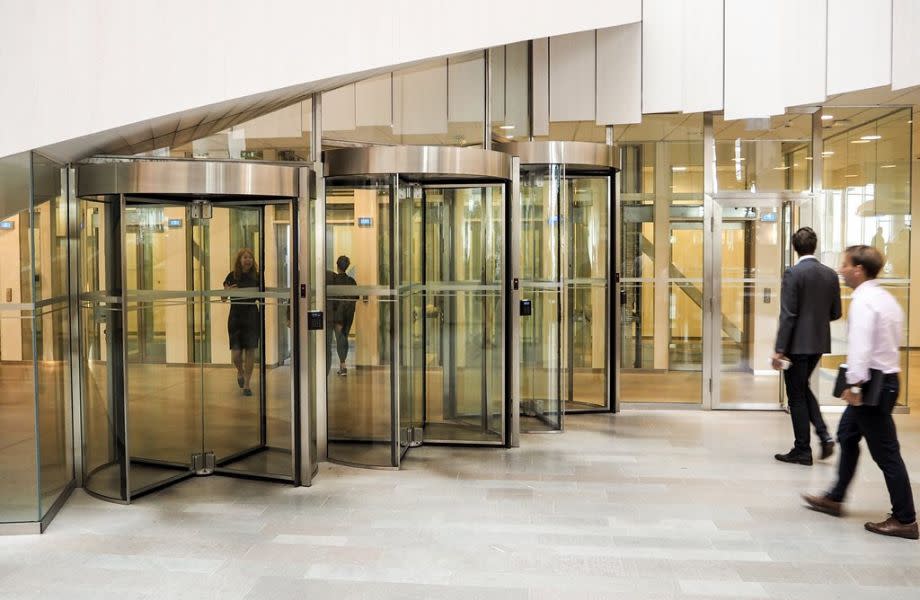
In order to get all these goods out quickly to highly diversified markets, logistics managers have increasingly turned to to handle more products from the same available space.
However, the growing complexity of the logistics industry brings forth three distinct security challenges in safeguarding and controlling entry to logistical and distribution facilities handling often valuable, sensitive and portable merchandise.
Protection against theft, against threats to staff, and against tampering, sabotage and the reputational damage resulting are the top priorities we at Boon Edam encounter as an entrance and security leader operating locally and globally in 27 of the major economies of the world.
The guidelines that follow are based on this global experience as an organisation that delivers complete layered security solutions from ranges available under the one roof—rather than being narrowly committed to just one type of solution.
And because of this growing need to protect people and product, Boon Edam continues to work extensively in securing the global distribution networks of the world’s largest e-commerce companies—including those that move millions of products a day—to keep these important facilities safe.
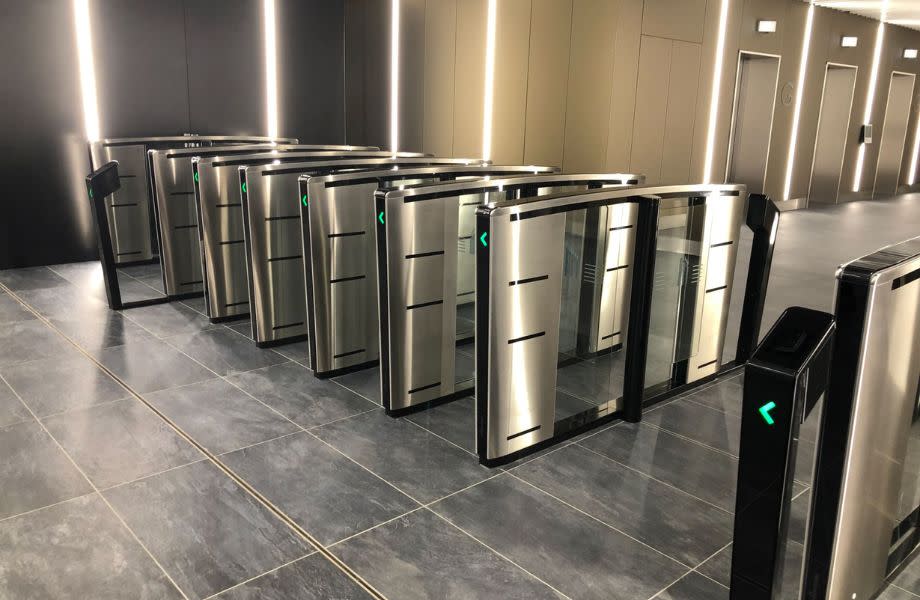
Understanding the various types of security challenges
Broad experience of entrance options is important, because one size or type of solution does not fit all challenges.
When it comes to physical security, there are many options available to choose among entrances designed to admit and record people who should be in a facility, and to exclude and provide security alerts about those who should not.
The first objective here is to create a layered security environment, tailored to the specific needs of different parts of a business and to the particular type of facility and goods being handled.
So, high-value, high-risk product areas—think pharmaceuticals or food that can be tampered with—naturally attract great attention.
So do IP and data areas vital to the business. And especially important also is the Duty of Care all employers have to provide a safe and secure environment in which valuable employees can function with the confidence that their employers are looking after their health and welfare, protecting them against intruders, sabotage and violence.
Security challenges fall under three major headings:
Theft
Employee theft refers to the act of employees taking or misusing their employer’s assets, which can include physical items, data, services, payroll, or cash, leading to financial loss and other negative consequences for the company.
The international anti-fraud and investigative case management business CaseIQ says the most common thing stolen from the workplace is inventory, with employees being responsible for nearly half of inventory shrinkage.
The consequences of employee (and contractor) theft include financial loss for the company, potential legal trouble, damage to reputation, and emotional strain on employers.
The sums can be exceptionally large.
Most current estimates suggest that more than $US50 billion in inventory is stolen from US businesses by employees on average every year.
E-commerce’s proportionate share of this is based on total US e-commerce of $US1.1 trillion, representing a penetration of 15 per cent of the overall retail market.
This compares with about 10 per cent in Australia and less than that in New Zealand—but e-commerce in both countries is already transacting in multi-billion dollars and expanding as local retailers move to digital platforms from which they can sell 24/7.
So theft is a problem that will inevitably grow.
Violence, sabotage and excluding perpetrators
Perhaps surprisingly, Australia and New Zealand are the regions where people say they have experienced workplace violence and harassment the most.
On a country basis, almost half (49 per cent) of Australians—more than any other country—and 42 per cent of workers from NZ have experienced it.
The global average stands at 21 per cent, according to a Lloyd’s Register Foundation World Risk Poll, powered by Gallup.
Australia’s report “Psychological health and safety in the workplace” highlights a concerning upwards trend of workplace violence and aggression.
Workers exposed to psychosocial hazards in the workplace were at greater risk of developing a work-related psychological injury, and poorer mental health outcomes.
Mental health conditions accounted for an increasing proportion of serious workers’ compensation claims, and had garnered significant attention over recent years as awareness of their impact on individuals and workplaces had grown.
Physical sabotage in the workplace—which can have serious repercussions on staff—involves damaging or destroying physical property, such as equipment, machinery, or tools.
This can be done intentionally or unintentionally, and can result in significant financial loss to the company.
As with theft of company assets [such as merchandise, cash, equipment, or confidential information] one of the best solutions is to prevent unauthorised access in the first place, and to record access and egress so as to identify perpetrators.
Protecting a shrinking labour pool
According to a recent survey of 2000 supply chain executives by the US Materials Handling Institute, 57 per cent of respondents state that hiring and retaining qualified workers is their greatest challenge, along with 56 per cent struggling with ongoing specific talent shortages.
Both Australia and New Zealand are also dealing with labour shortages arising during Covid and persisting to this day, particularly in the case of Australia, where staff retention is a priority because supply chains are profoundly impacted by skills and labour availability.
From sourcing to production, logistics, and delivery of goods and services, industries such as warehousing and distribution face a critical shortage of manual labour, making it challenging to find and retain workers to run warehouse floors.
Physical security serves as a shield for such workers against unauthorised access while protecting against theft, vandalism, and violence.
In workplaces, educational facilities and other public spaces, physical security is the first line of defence.
It not only prevents unauthorised entry but also creates a sense of safety and calmness.
Providing a secure, stable and healthy workplace is an asset to retention and productivity.
Budgeting for physical security entry solutions
The strategic application of different types of secured entry solutions enables warehouses and logistics facilities to effectively address all three challenges above in a single budget line item, ensuring a comprehensive approach to operations and security.
Options include security revolving doors, security portals and speed gates.
These options vary greatly in their capabilities and it can be difficult for security managers looking to secure their logistics and warehouse facilities to select the proper security entrance that meets their specific goals.
To assist professionals in selecting the right entrance solution, we have categorised security entrances by their level of security, as it relates to unauthorised entry attempts such as tailgating or piggybacking.
In deciding the best approach for particular enterprises, operators need first to determine goals, such as:
Deter unauthorised entry
While all security entrances are a physical deterrent against intrusion, full height and waist high turnstiles often do not have presence sensors or alarms to alert guard staff of infiltration.
Therefore, their presence visually deters casual attempts at defeat by climbing or crawling over.
Solutions that deter unauthorised access are appropriate for facilities that have high throughput in distribution centres and warehouses.
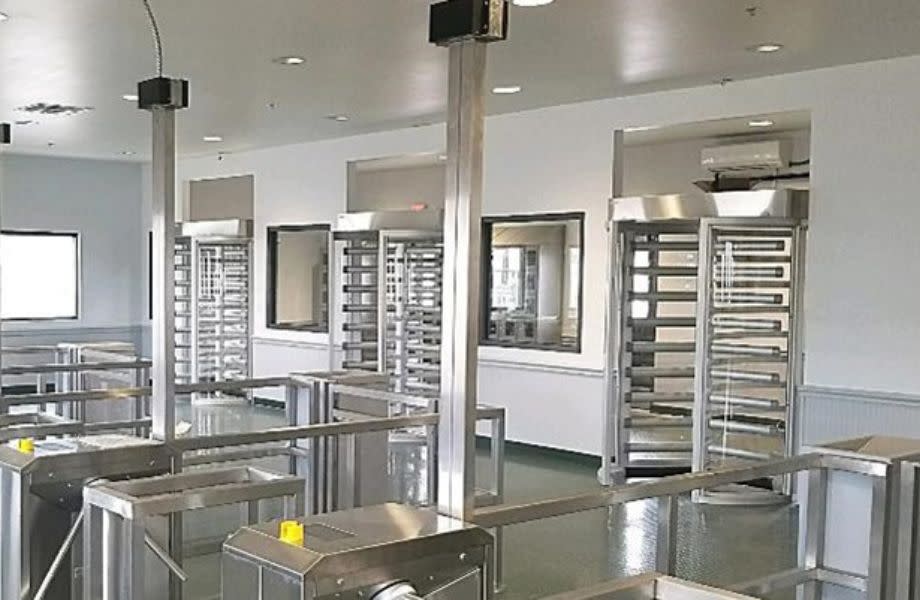
Detect unauthorised entry
When it is critical to balance security and visitor management, entrance solutions that detect tailgating are key.
Speed gates provide stronger obstacles against intrusion and, when coupled with biometric and access control devices, can raise alarms to alert guard staff of unauthorised entry in real time for quick action.
This category of solution facilitates both internal security and visitor management operations and can also support regulatory and risk reduction compliance mandates.
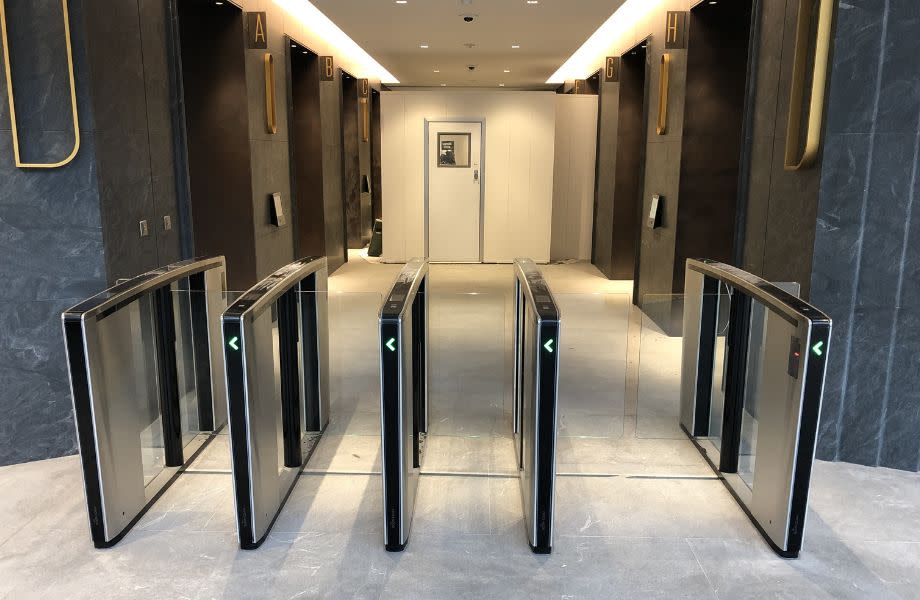
Prevent unauthorised entry
When security is critical, security revolving doors and interlocking security portals reliably prevent intrusion without the need for manual oversight.
Virtually impenetrable, these solutions allow for the elimination or reallocation of guard supervision, providing owners with a quick return on investment.
Also, by examining metrics gathered by the sophisticated overhead sensor systems in the doors, owners can predict and quantify their actual risk of infiltration.
Used often at employee-only entrances and to secure management offices, security entrances that prevent unauthorised access deliver the highest level of protection.
By better controlling who comes and goes from logistics facilities, operators can better control what leaves your facilities.
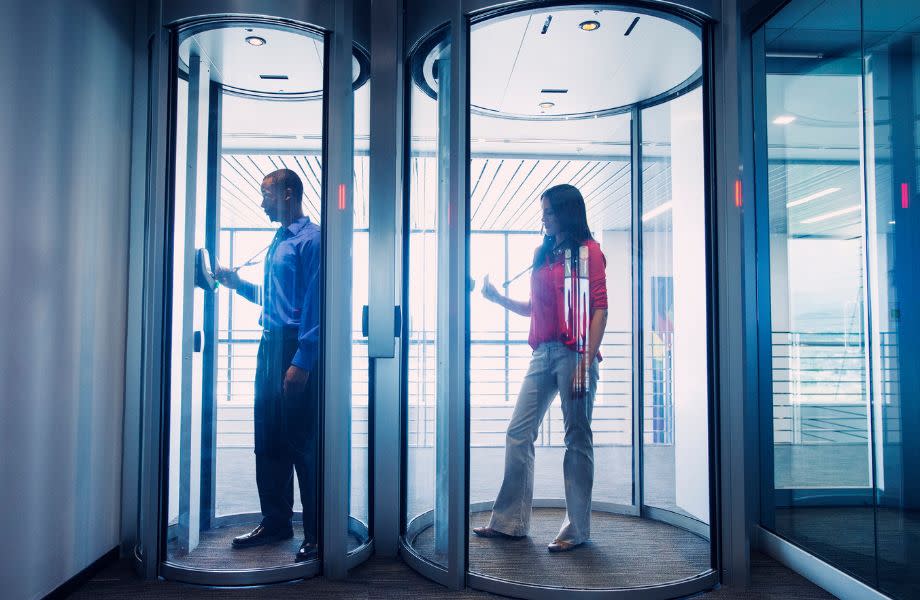
But with all the different entry solutions, products, sensors, and AI video analytics available, selecting the right combination of devices and technologies can be an arduous task.
The design/selection process for secured entry solutions must include optimising time, training, labour resources, and where feasible, the deployment of new technologies.
So, with so many security doors and turnstiles available, what is the most effective application of secured entry solutions to accomplish this?
While each layered solutions application is unique, industry-best practices have resulted in the blending of loss prevention and employee safety into the entry/exit workflow and design process.
In doing so, solutions such as those discussed deliver the following benefits:
Provide access and security for the warehouse environment
Deliver excellent high-capacity throughput
Ensure sophisticated visitor channel flow and provide safety after-hours with night-locking doors and protection packages
Offer rapid technical troubleshooting for reduced downtime
Involve collaboration with an entry expert for all phases of the project (selection, installation, commissioning, and maintenance)
Deploying security entrances and secured workflow technology at entry and exit points controls who comes and goes through the areas involved.
A major benefit of these secured entry solutions is that they automate many of the manual processes currently associated with loss prevention.
By reducing, or even eliminating, much of the physical labour required to sustain manual loss prevention processes, secured entry solutions deliver tangible results and cost savings.
This is especially so where many logistics and warehouse facilities choose to employ guards as a part of their security strategy.
While guards provide a strong physical deterrence, the recent talent shortage has made sourcing reliable staff an increasingly expensive challenge for many distribution centres.
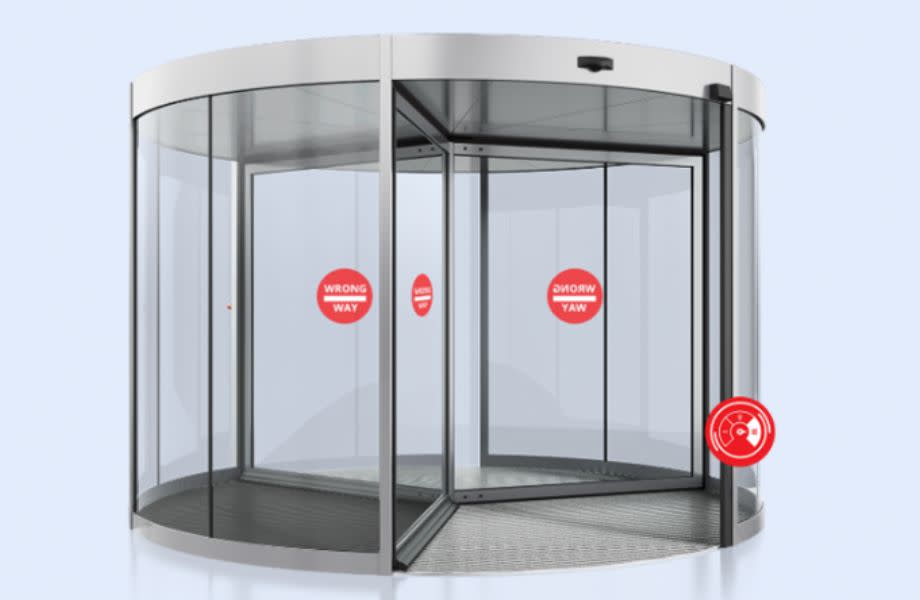
Like other industries, more is being asked of employed guards in order to compensate for a reduction in staff.
Guards are working longer hours and performing more tasks than ever before. This can increase costs and inefficiencies where overworked guards are fatigued and more likely to make mistakes.
Security entrances, operating 24/7, can successfully fill the gap between labour supply and demand by offering solutions that operate independently of, or in tandem with, security guards.
Their work can be focussed in areas where and when they are most effective.
Not only does security technology increase overall security levels substantially but it can also provide strong RoI.
In most cases, a Boon Edam tailgating and piggybacking prevention design, for example, will net RoI in less than eight months from deployment in facilities that operate all day, every day.
Just as automation is benefitting e-commerce’s ability to deliver more goods more quickly, entrance security solutions also reduce the current strain on human capital.
Carefully selected technology-based security alternatives likewise enhance RoI while achieving the increasing security needs of an industry facing expanding challenges of inventory loss, workplace protection and the safety of an increasingly valuable workforce.
About the author
Michael Fisher is managing director of Boon Edam Australia, which is part of the privately owned international Royal Boon Edam group, which provides architectural revolving door and layered security solutions to some of the world’s largest companies, Fortune 500 companies, and companies in Australia, New Zealand and Papua New Guinea including financial, data and telecommunications, federal and state government, hospitality, health and aged-care, logistics, retail, and distribution facilities.
The Urban Developer is proud to partner with Boon Edam to deliver this article to you. In doing so, we can continue to publish our daily news, information, insights and opinion to you, our valued readers.
About Royal Boon Edam
With work environments becoming increasingly global and dynamic, smart, safe entry has become the centre of activity in and around many buildings. Royal Boon Edam is a global market leader in reliable entry solutions. Headquartered in the Netherlands, with 150 years of experience in engineering quality, we have gained extensive expertise in managing the transit of people through office buildings, airports, healthcare facilities, hotels, and many other types of buildings. We are focussed on providing an optimal, sustainable experience for our clients and their clients. By working together with you, our client, we help determine the exact requirements for the entry point in and around your building.
Please take a look at our range of revolving doors, security doors & portals, speed gates, tripod turnstiles, access gates and full height turnstiles to ensure the security of your entry and perimeter.
You can find more news about Boon Edam on www.boonedam.com.au/news













